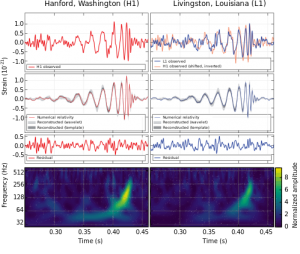Oct 11 – Gravitational Waves and LIGO: A Technical History
Thursday, October 11, 2018
6:00 PM: Doors open for refreshments and networking
6:30 to 8:30 PM: Presentation and Questions
SOLD OUT
Venue: KeyPoint Credit Union
2805 Bowers Ave (just off Central Expressway)
Santa Clara, CA 95051
Park in lot adjacent to building on Bowers Ave.
Our Thanks To KeyPoint Credit Union
IEEE SV Tech History committee is extremely grateful to KeyPoint Credit Union for use of their auditorium as a venue.
Many thanks to Doron Noyman of KeyPoint for his support in making this happen.
Gravitational Waves and
The Laser Interferometer Gravitational-wave Observatory (LIGO):
A Technical History
This session will comprise a talk by Stan Whitcomb followed by a panel discussion.
Talk Abstract:
The first detection of gravitational waves by the LIGO is remarkable not only because of its impact on the Theory of General Relativity and on the astrophysics of neutron stars and black holes, but also because of the sensitivity of the detectors required. The LIGO interferometers had to be capable of discerning changes as small as 1E-18 m in the length of its 4-km long arms, certainly one of the most precise physical measurements ever made.
The LIGO Lab is operated by Caltech and MIT through funding from the National Science Foundation. It comprises observatories in Livingston, Louisiana and Hanford, Washington, in addition to the groups at Caltech and MIT. The broader LIGO Scientific Collaboration currently includes approximately 1000 scientists, engineers and students from more than 60 institutions in 12 countries. After thirty-five years of development and construction,
The first gravity waves detected by LIGO were created by the collision of two black holes was made simultaneously in Louisiana and Washington State on September 14, 2015 and announced on February 11, 2016. The detection of gravity waves confirmed the predictions of Einstein’s General Theory of Relativity and ushered in a new era of gravitational wave astronomy.
With its partner the Virgo Project, LIGO will form the core of an international network of gravitational wave detectors, seeking to learn about the universe through a new type of signal. To achieve this incredible sensitivity, LIGO scientists spent over 30 years understanding and overcoming a plethora of competing noise sources.
In this talk, Stan Whitcomb will describe a diverse handful of these noise sources, selected because of their importance to the project or their broader general interest, and trace the sometimes circuitous path that led to each one being brought under control
Panel:
- Tom Coughlin, Moderator:
Storage Technology Consultant
- Stan Whitcomb PhD, Former Chief Scientist of the Laser Interferometer Gravitational-wave Observatory
Stan received his BS degree in 1973 from Caltech and then a PhD at the University of Chicago in far-infrared and submillimeter astronomy in 1980. He returned to Caltech in 1980 as an assistant professor of physics, near the beginning of Caltech’s entry into the field of gravitational wave detection. He has been involved in nearly every phase of the effort to build LIGO—concept development, prototype sensitivity demonstration, detector design and installation, commissioning, data analysis, and management. He is a Fellow of the American Physical Society and of the Optical Society. He was awarded the Henry Draper Medal (National Academy of Sciences) in 2017, and the C.E.K. Mees Medal (OSA) in 2018.
- Brian Lantz PhD, Senior Research Scientist, LIGO Group, Stanford University
LinkedIn Biography
- David Adler PhD, President and CEO of Silicon Valley X-Ray (SVXR)
In 1981 Dave a sophomore at Caltech was offered a summer job by his physics teaching assistant, Yekta Gursel, to “build a gravity wave detector” on campus. That summer they bolted together the 40-meter predecessor to LIGO. For his senior thesis, Dave worked with Stan Whitcomb to develop a laser stabilizer for the gravity wave detector. Since then, Dave has developed novel optical systems using ions, electrons and x-rays. He has about 100 patents covering ion, x-ray and electron optics and semiconductor inspection. He started SVXR in 2012 to develop 100x faster x-ray inspection systems.

